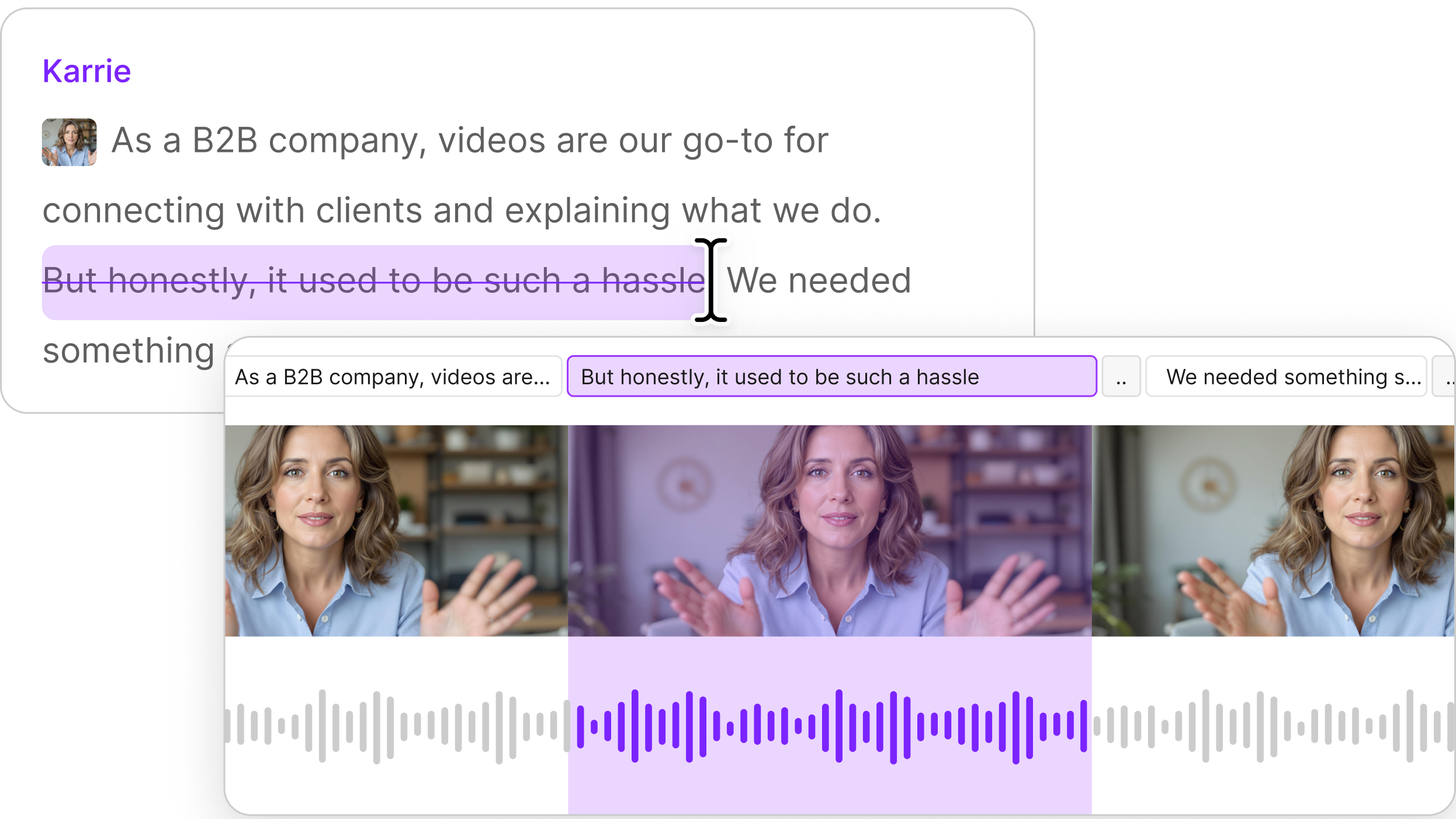PowerPoint presentations have earned their reputation for being forgettable. Behind every polite nod in a meeting room, there's someone waiting for something—anything—more engaging than wall-to-wall text.
The challenge isn't just figuring out what to say—it's finding ways to make your content stick when attention spans are measured in seconds, not minutes.
That's where embedded videos come in. Look at Dr. Frans de Waal's TED Talk on inequity aversion. Instead of lecturing about theory, he showed videos of monkeys rejecting unequal pay (cucumber vs. grapes). The result? Over 5 million views for what could have been a standard academic presentation.
This guide will show you exactly how to embed videos in PowerPoint—no technical degree required. Whether you're pitching to clients or presenting to colleagues, you'll learn how to transform your slides from forgettable to impossible to ignore.
How to embed a video in PowerPoint using an HTML embed code
Some online video platforms, like Vimeo, offer an iframe embed code that you can copy and paste directly into PowerPoint. To do this, locate the video on Vimeo, click “Share,” and choose “Embed” to reveal the iframe code. From there, open your PowerPoint presentation, select “Insert,” then “Video,” and choose “Online Video” where you’ll paste the embed code before clicking insert. PowerPoint will automatically recognize the HTML code and display the video thumbnail on your slide, ensuring a professional look. Be sure to check that your embed code starts with <iframe> and ends with </iframe> so that PowerPoint can interpret it correctly according to Microsoft support. This approach can be especially useful for streaming high-quality content without inflating your presentation’s file size for more details.
Troubleshooting video embedding issues in PowerPoint
Even though embedding videos in PowerPoint is straightforward, users may encounter issues like unsupported file formats or missing codecs. To avoid such problems, ensure your video is in a supported format, such as MP4 with H.264 video and AAC audio. If a video doesn't play, check for missing codecs and install them as needed. Additionally, verify your video links, especially when embedding online videos, to prevent broken links from disrupting your presentation. For optimal playback across different devices, test your presentation before delivering it.
Advanced playback options in PowerPoint
If you want more control over how your embedded videos look and play, PowerPoint offers advanced playback tools like trimming, fade-in, and fade-out. Trimming allows you to specify the exact start and end points, which is helpful if you only want to show a focused segment as recommended by Microsoft. Fade-in and fade-out effects let you create smooth transitions for your video’s entry and exit during slides. After selecting the video, you can find these playback controls under the ‘Playback’ tab in the PowerPoint ribbon. Always preview the slide to make sure the timing aligns with any spoken commentary or animations you’ve added. By fine-tuning these settings, you elevate the production value of your presentation without needing specialized editing software.
How to embed a video in PowerPoint from your computer
First, you'll need a video—either from an online source or your media library. While you could manually play the video from another website or program during your PowerPoint presentation, this approach can be cumbersome and prone to technical issues.
Fortunately, embedding a video in PowerPoint is straightforward. You can either link to an external video file or embed it directly within your presentation.
Use the tutorial below to insert videos in PowerPoint from a computer.
How to embed a video in PowerPoint on Windows
Step 1: Select the PowerPoint slide
Launch Microsoft PowerPoint on a Windows computer and open a blank or existing PowerPoint file.
Then, go to the slide you want to embed a video and select the Insert tab in the toolbar.
|
Step 2: Click Insert > Video > This Device
Select the Video option. Here, you can either embed a video from your computer or from an online source, like a website or YouTube and other supported platforms.
Click This Device from the drop-down menu to embed a video from a folder on your computer.
|
PowerPoint supports MP4 files encoded with H.264 video and AAC audio. Additionally, you can insert videos in formats such as M4V, MOV, ASF, AVI, MPG, MPEG, and WMV. If your file format isn't supported, consider converting it to ensure compatibility.
If you don't want to play a video full screen, resize it to your preferred dimensions.
For precise height-to-width proportions:
- Select Format (PowerPoint 2013 or newer) or Options (PowerPoint 2010) in the Size group
- Click the Dialog Box Launcher Icon image
- Click Size, then select the Lock aspect ratio checkbox under Scale
- Enter your preferred height and width under Size and rotate or enter the percentage of size that you want in the Scale height and width boxes
Then, select Video Format to access formatting options like borders and effects or right-click the video for more options. You can also use the Designer tool to choose from professional slide templates.
|
Then, click the Playback tab to trim your video, add captions, and set playback preferences such as 'In Click Sequence,' 'Automatically,' or 'When Clicked On.' This ensures the video plays exactly as intended during the presentation.
Note: In PowerPoint for Microsoft Office 365 or PowerPoint 2016 version 1709 or later, you can use the In Click Sequence option. This way, your video can play in sequence with other actions you've programmed on the slide, like animations or transitions.
To insert a web video, select Video > Online Videos.
|
Note: PowerPoint supports embedding videos from platforms such as YouTube, SlideShare, Vimeo, Microsoft Stream, and Flip, allowing for more flexibility in your presentations. When embedding from these platforms, ensure you have a stable internet connection during your presentation, as online videos require connectivity to play properly.
Step 3: Click Insert
If you choose to embed an online video, copy the link to the video you want to embed and paste it in the blank field. A preview of your video will appear in the Insert video pop-up.
|
Click the Insert button to embed the video in your presentation.
|
PowerPoint will download and insert the video on the selected slide. You can drag the edges of the video thumbnail to resize it, then use Video Format options, like shape, border, and effects to enhance the video.
Select the Playback tab to insert captions or choose how your video plays (automatically or when clicked).
|
Note: While you can't adjust when an online video starts playing directly in PowerPoint, if you're embedding a YouTube video, you can copy the video URL at a specific timestamp to start playback from that point. This is useful when you only want to show a specific segment of a longer video during your presentation.
Click the Slide Show tab to preview the video with all the formatting changes you made. Then, save your presentation to your computer or click the Share button to move or copy it to the cloud.
How to embed a video in PowerPoint on Mac
To embed a video in PowerPoint for Mac, you'll need to save the video file in the same folder as your presentation.
Step 1: Select the PowerPoint slide
Launch PowerPoint and open a blank or existing presentation, then select the slide you'd like to add a video to.
Select Insert.
|
Step 2: Click Insert > Video > From File
Click Video to access video embed options from the drop-down menu:
- Video browser
- Video from file
- Stock videos
- Online film
Select Video from file to insert a video file from your Mac.
|
Step 3: Click Insert
In the Choose a Video dialog box, select the video file you want to insert, then click the Insert button to embed the video on the slide.
|
If you want to put a link to the video on the slide, click Show Options in the lower left corner of the dialog box.
|
Then, select the Link to file box, and click Insert.
|
Select the Video Format tab to add effects and choose whether your video will play automatically or when clicked.
|
Tip: If you're using the 2016 version of PowerPoint (or newer), you can play back videos with multiple audio tracks. These versions also support closed captions and subtitles embedded in video files.
Select the Playback tab to do the following:
- Trim your video
- Add fade in and fade out effects
- Play the video on full screen or hide during the show
- Insert captions
- Select start time options (in click sequence, automatically, or when clicked)
Loop the video to play repeatedly and continuously during the presentation
- Rewind your video
How to embed a YouTube video in PowerPoint
Embedding a YouTube video to a PowerPoint presentation is simple. You can use the video URL or integrated search function to embed a video you uploaded to YouTube or someone else's video (with permission).
To add a video to your PowerPoint presentation, you'll copy the video embed code and paste it into the slide you want. The code will load the video at the source and play it on the platform you're using.
You won't need to download and upload the video from YouTube and the video will load and play faster regardless of the file size. Plus, you can share video content that's covered under copyright, so you're not in danger of crossing any legal lines. However, remember that you'll need an active internet connection for embedded YouTube videos to play during your presentation.
Follow these steps to embed a video in PowerPoint from YouTube on a Windows PC or Mac.
How to embed YouTube videos in PowerPoint on Windows
Step 1: Click Insert tab
Open a PowerPoint presentation and select the slide you want to embed your video.
Click Insert > Video.
Step 2: Select Online Video
Select the Online Videos option.
|
Step 3: Paste the YouTube video URL
Right-click the video to copy the video link or embed code, or click Share to get the embed code. Then, paste the URL or embed code in the link field.
|
A preview of your video will appear in the Insert video dialog box.
Click Insert to embed the video in your presentation.
|
Resize the video thumbnail, then use the video formatting options to enhance it.
Click Playback play the video automatically or when clicked or add captions. Then, preview the video with all the edits you made and save or share your presentation.
Note: YouTube's video file formats are similar to those PowerPoint supports, so your video will likely play without issues. However, YouTube supports some formats that PowerPoint doesn't, including FLV, 3GPP, WebM, DNxHR, ProRes, HEVC (h265), and CineForm. If your video isn't playing, check to make sure it's a supported file format.
How to embed YouTube videos in PowerPoint on Mac
Step 1: Click Insert tab
Open a PowerPoint presentation and select the slide you want to embed your video.
Click Insert > Video.
Step 2: Select Online Video
Select Online Film.
|
A URL pop-up will appear prompting you to enter the link to the YouTube video.
|
Step 3: Paste the YouTube video URL
Go to YouTube and copy the link or embed code of the video you want to embed in your presentation. You can right-click the video and select copy video URL or copy embed code, or click Share and copy the video link or embed code.
Paste the video link or embed code in the URL pop-up in your PowerPoint presentation, then click Insert.
|
Resize your video and polish your slides before saving the presentation to your computer.
|
How to link a video file in PowerPoint
Embedding a video in PowerPoint is convenient but can significantly increase the file size of your presentation. If file size is a concern, consider linking to an external video instead of embedding it directly. PowerPoint presentations with embedded videos may also take longer to load and might not perform well on computers with limited resources.
To reduce your presentation file size, insert a video file link to create a linked video. The downside with linked videos is that links can break, but you can prevent this by copying and storing your presentation and linked videos in the same folder, then linking to the video there. For important presentations, always test linked videos on the actual presentation device beforehand.
Ensure you have a stable internet connection, then use the steps below to insert a video file link in PowerPoint on a PC or Mac.
How to link video files in PowerPoint
Step 1: Take a screenshot of the video
Find the video you want to link to in PowerPoint and take a screenshot of the clip.
To take a screenshot in Windows, you can either use the Snipping tool, press the PrtScn (print screen) key and Windows Logo key on your keyboard.
If you're using a Mac computer, you can take a screenshot by pressing and holding SHIFT + COMMAND + 3 keys together (for full screenshot) or SHIFT + COMMAND + 4 keys to screenshot a specific area.
Step 2: Insert the screenshot in your slide
Alternatively, navigate to the slide you want to add your screenshot to, select Insert > Pictures > Picture from File. Then, find the screenshot you took, select Insert to add it to the slide, then crop, resize, and position it to your liking.
|
Step 3: Hyperlink the image to your video
Right-click the image and select Link.
|
If your video is in Descript, copy the video link from your dashboard.
|
Insert the video link in the address field then click OK.
|
The hyperlink will be connected to the image itself, not other elements on the slide or the entire slide.
Click Slide Show to test your video and ensure it links to the right video. When you click on the image, it will open in a web browser, ready for you to play.
|
Embedding vs. linking videos in PowerPoint
When incorporating videos into a PowerPoint presentation, you can choose between embedding or linking the video. Embedding ensures reliable playback without the need for an internet connection, although it increases the file size. Linking keeps the file size smaller but requires an internet connection and carries the risk of broken links. Consider the presentation environment and available resources to decide which method suits your needs best. For critical presentations, having both an embedded version and a linked backup can provide additional security.
Why can't I embed a video in PowerPoint?
Embedding videos to a PowerPoint presentation is a straightforward process, but sometimes the video may fail to play. Let's review some reasons for playback failure and how to resolve them.
Fixing video playback issues in PowerPoint
Video playback may fail in PowerPoint due to unsupported formats, missing codecs, or broken video links. Ensuring your video file is in a compatible format (like MP4 with H.264 encoding) and testing it before the presentation can help avoid issues. For online videos, verify your internet connection will be stable during the presentation.
- The storage folder is corrupt
- The video's audio is out of sync
- The video file is corrupt, damaged, in an unsupported file format, or missing certain files
How to fix: Convert your video into a supported file format, check PowerPoint playback settings, or make the video visible by unchecking the Hide while not playing option in the playback tab. You can also save your presentation using the PPT or PPTX extension, so it's easier to open the file in older or modern Office versions. Before any important presentation, always test your videos on the actual device you'll be using to present.
Resolving file size and compatibility problems
Your video might not play if the file is too big. To resolve this issue, compress the media file by going to File > Info > Compress Media. Then, select one of these options:
Presentation quality/full HD: Adjusts the video size while maintaining its quality.
Internet quality/HD: Saves on space and video quality.
Low quality/Standard: Saves more space but doesn't keep overall video and audio quality. This option is ideal if you want to share the presentation with others and ensure your videos will still play.
If your video file is incompatible with PowerPoint, it may be in an unsupported file format or missing a codec.
How to fix: Convert the video to a supported format or add a missing codec to your computer for smooth playback.
Handling broken video links in PowerPoint
When adding an online video, you might accidentally enter an incorrect link or the video link may be broken at the source. This means it won't embed correctly and won't play when you're presenting.
How to fix: Before embedding an online video, ensure PowerPoint is up to date and verify that the video link is correct. Test the video to confirm it plays properly across different devices. For important presentations, consider downloading a local copy of the video as a backup in case of internet connectivity issues.
How to create professional videos for PowerPoint
Embedding a video in PowerPoint is a pretty simple process with several benefits for you and your audience. To prevent yawns and glazed-over eyes, you'll need professional-quality videos that will draw your audience in, keep them engaged, and improve message recall. Videos can bring your presentations to life by adding movement, sound, and visual interest that static slides simply can't match.
Descript's video editing software allows you to create high-quality videos that can be seamlessly embedded in PowerPoint presentations. With AI-powered features like automatic transcription and Studio Sound, you can enhance your video content for better engagement.
Plus, Descript's AI-powered automatic transcription generates high-quality transcripts from your video's audio, which you can use as notes while making your presentation. You can also use Descript's AI features to get text summaries, auto-generate copy for social media posts, and enhance your audio with Studio Sound.
Take Descript for a spin today to make quality videos that will help you deliver exceptional PowerPoint presentations.
Frequently asked questions about videos in PowerPoint
How do I embed a video in PowerPoint?
To embed a video in PowerPoint, go to the Insert tab, select Video, and choose either Online Video or Video on My PC. Follow the prompts to insert your chosen video into the slide.
Is it better to embed or link a video in PowerPoint?
Embedding a video is more reliable as it ensures playback without needing an internet connection, but it increases the file size of your presentation. Linking a video keeps the file size smaller but may lead to playback issues if the internet connection is unstable or the link breaks.
Can I embed a Vimeo video in PowerPoint the same way I embed a YouTube video?
Yes, you can embed a Vimeo video into PowerPoint the same way you would a YouTube video, by using an iframe embed code. According to Microsoft support, you simply copy the iframe code from Vimeo, then paste it into the ‘Online Video’ option in PowerPoint. Just make sure your code starts and ends with <iframe> tags, or else PowerPoint may not recognize it per troubleshooting guidelines. Remember that you’ll need an active internet connection to stream the content during your presentation.
How do I download a video for offline playback in PowerPoint?
To download a video for offline playback, you first need a reliable third-party tool or software that can save videos from platforms like YouTube as recommended by Microsoft. After saving the file in a compatible format such as .mp4 or .wmv, open PowerPoint and select Insert > Video > Movie from File to add it to your slide. Be sure to test the embedded file on the same device you’ll use for the presentation to avoid playback issues. If space is an issue, you can compress the media under File > Info > Compress Media. This approach ensures smooth playback even without an internet connection.























































%20(1).JPG)





